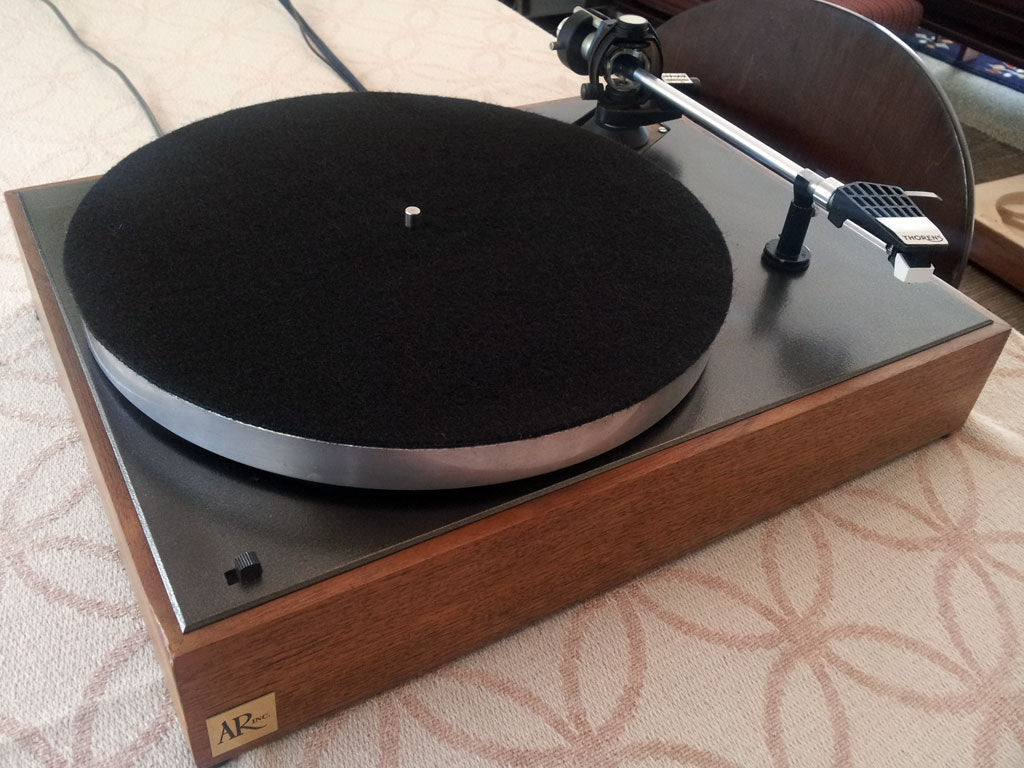When the AR XA turntable came out in 1961, it was an instant classic – almost immune to external shocks and vibrations, low in rumble, and priced at a shockingly affordable $58.00 ($489 today), less cartridge but complete with arm, dustcover, and even a stylus force gauge. (The price was soon raised to a more sustainable $78, or $658 today.) It was a runaway success. AR sold hundreds of thousands of them. The Museum of Modern Art acquired one for its industrial design collection. And fifty years after its arrival, The Absolute Sound listed it first in its article, “The Ten Most Significant Turntables of All Time.”
Its key technologies were widely adopted by other companies, and are still in use. One of those key technologies was the AR’s mounting system. Instead of attaching the platter, motor, and tonearm to the turntable’s top plate, AR mounted its arm and platter to a subplatform, suspended below the top plate at three points by damped springs with a very low resonant frequency. This isolated the arm and record from footfall vibrations or acoustic feedback. In demonstrations, AR representatives would hit the top plate with a hammer (reportedly a padded one) without making the arm skip in the groove. To keep motor vibrations from reaching the record and stylus, the turntable used a belt drive, with the motor mounted to the top plate rather than the subplatform.
The other key technology was the use of a low-speed, low-power synchronous motor and a light platter instead of a heavy platter and large motor, (Early versions of the AR XA had a second motor, to ensure the main motor started in the right direction.) The lightweight motor generated less rumble than more massive ones, and its low speed lowered the rumble frequency to a subsonic 5 Hz. The lighter platter had less speed-stabilizing flywheel effect than the heavy platters then (and now) in common use, but the speed of synchronous motors is extremely accurate and stable to begin with. Reviewers at the time remarked on the AR XA’s low rumble and smooth, accurate speed, and other belt-drive turntables with subplatform suspensions, such as the Thorens TD-150 and Linn Sondek LP12 (No. 2 on the TAS “Significant Turntable” list), arrived soon after.

But neither the subplatform nor the light, slow motor originated with AR. The company – by its own admission – got these ideas from Stromberg-Carlson, an old-line supplier of telephone equipment that also sold audio equipment. Stromberg-Carlson was one of the few companies to make both phonograph consoles and audio components. They even had a product that bridged their console and component product lines, a wood console cabinet with slots to hold whatever mix of Stromberg-Carlson components you desired: a tuner, your choice of two amplifiers, and either a record changer or a single-play turntable. That table, the cheery red, variable-speed, “Perfectempo” PR-499, introduced both subplatform suspension and lightweight motors to a general audiophile audience. The PR-499 sold for $99.95 in 1958 ($884 today); its companion arm, with a unipivot suspension, was $24.95 ($221).

But subplatform suspension didn’t originate with Stromberg-Carlson, either. The first subplatform turntable was probably the H.H. Scott 710A of 1955. It used a more conventional motor, though, and shaft drive. The small-motor, lightweight-drive system didn’t originate with Stromberg-Carlson. It came, circa 1959 or 1960, from the fertile mind of Paul Weathers, better known for his FM phono cartridge. He rejected the heavy platters whose flywheel effect helped most turntables of the day maintain steady speed and smooth out the small speed variations audible as wow and flutter: heavy platters, and motors strong enough to turn them, had more rumble, and heavy-duty construction added cost. So Weathers’ turntable used an electric-clock motor for its extreme speed accuracy, low cost, and the fact that “eliminating the need for a large, inherently noisy motor gets rid of rumble at its source.” But that motor's low power could only handle a light load, so he used a platter stamped out of thin, non-resonant aluminum, riding on a single-needle bearing. That led to the ultimate in drive-system simplicity.
Many turntables, back then, used stiff rubber idler wheels to transmit power from the motor shaft to the rim of the platter. To drive a heavy platter, the idler had to be pressed hard against the motor and platter during play. But when the turntable was at rest, the idler had to be moved away from the motor and platter so the rubber wouldn't develop flat spots that would create periodic thumps and slight speed changes during record play. Weathers’ ultra-light platter could be driven by a soft rubber wheel that would not develop flat spots, so it didn’t require a mechanism to move it out of position when the platter was stopped.

That simplicity made the Weathers turntable ideal for kit construction. The kit version could be assembled with only pliers and a screwdriver, with no soldering required, and sold for only $49.95. That’s $427 in today’s money, but somehow $50 was easier to get back then than $400 is today – even as a college student on a scholarship, I managed to buy and build one. It was my first single-play turntable, and my first true high-fidelity component.
Header image courtesy of Wikimedia Commons/Jacques.



